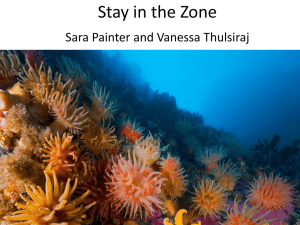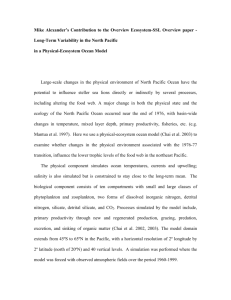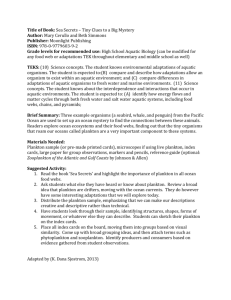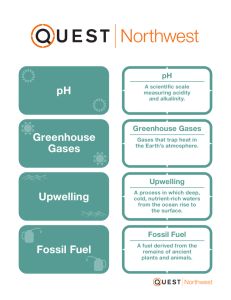Chapter 17
advertisement
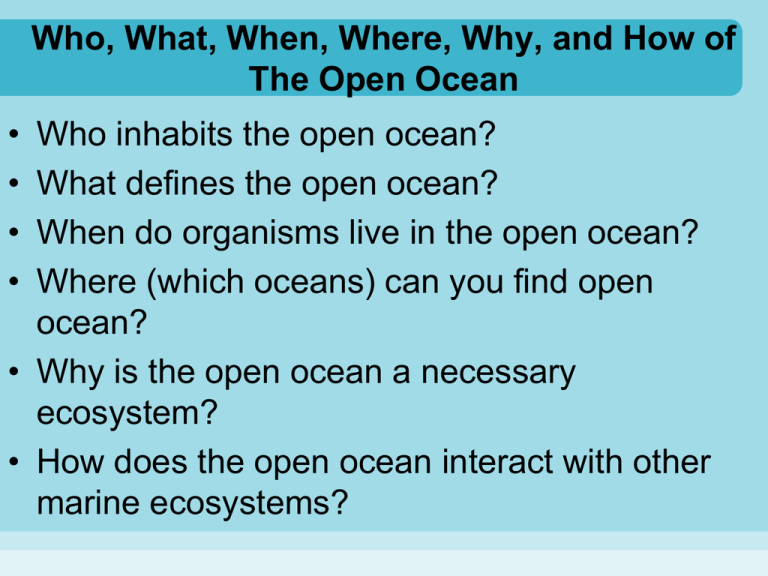
Who, What, When, Where, Why, and How of The Open Ocean • • • • Who inhabits the open ocean? What defines the open ocean? When do organisms live in the open ocean? Where (which oceans) can you find open ocean? • Why is the open ocean a necessary ecosystem? • How does the open ocean interact with other marine ecosystems? Chapter 17 The Open Sea Karleskint Turner Small Regions of the Open Sea • The open ocean lies beyond the neritic zone • Vertical zonation depends on penetration of sufficient sunlight to support photosynthesis – photic zone: receives enough light for phytoplankton to survive • can extend to a depth of 200 meters (660 ft) in clear tropical waters • Epipelagic zone (corresponds to the photic zone): the location of pelagic animals in the upper 200 m of the ocean • Aphotic zone: light rapidly disappears until the environment is totally dark Life in the Open Sea • Two groups of organisms inhabit the oceanic zone: plankton and nekton – based on productivity, biomass, abundance and diversity, plankton far outweighs nekton in open ocean • Classification of plankton • Plankton can be classified into logical groups based on: – – – – – taxonomy motility size life history spatial distribution Life in the Open Sea • Classification of plankton – Classifying them into different groups: • phytoplankton: primary producers • zooplankton: heterotrophic eukaryotic microbes that float in the currents • bacterioplankton: archaeans and bacteria • viriplankton: free viruses (the most abundant plankton of all) Life in the Open Sea • Classification of plankton – Classifying based on motility • akinetic: plankton that don’t move at all, e.g., viruses, diatoms • kinetic: plankton that can move (include majority of plankton) – kinetic plankton move by use of flagella, jet propulsion, undulation, swimming appendages Life in the Open Sea • Classification of plankton – Classifying based on size • original scheme (based on visibilty and collection method): – macroplankton – visible to the naked eye – microplankton – caught with standard plankton net – nanoplankton – concentrated by centrifugation • newer classifications: – – – – – Femtoplankton – less than 0.2µm Picoplankton – 0.2-2.0µm Mesoplankton – 2.0µm-20mm Macroplankton megaplankton Life in the Open Sea • Classification of plankton – Classifying based on life history • holoplankton: organisms that are planktonic throughout their lives, e.g., microbes, arrowworms, salps, siphonophores, comb jellies, copepods, krill • meroplankton: planktonic larvae that will grow into non-planktonic organisms – in open ocean would include larvae of nektonic fish and squid – in coastal waters would also include larvae of benthic invertebrates Life in the Open Sea • Classification of plankton – Classifying based on spatial distribution • neritic: distinguished by presence of meroplankton and diverse diatoms • oceanic: less diverse in diatoms and invertebrate meroplankton; more salps, larvaceans, arrowworms and sea butterflies • neuston: plankton that live close to the water’s surface • pleuston: plankton which break the surface of the water with their gas bladders or bubbles, e.g., bythe-wind sailor Life in the Open Sea • Patchiness in the open sea – plankton occur in patches (localized aggregations), often around upwellings – patchiness can be caused by: • • • • • • upwelling localized variations in sea surface conditions vertical mixing downwelling waters of different densities coming together grazing by zooplankton Life in the Open Sea • Patchiness in the open sea (continued) – micropatchiness occurs throughout the photic zone when marine microbes become attached to particles of organic matter, esp. marine snow • marine snow: strands of mucus secreted by zooplankton that form translucent, cob-webby aggregates Life in the Open Sea • Plankton migrations – many open-ocean zooplankton migrate daily from the surface to nearly 1.6 km deep • provides access to phytoplankton in the photic zone • reduces predation by plankton-eating fishes in the epipelagic zone – deep scattering layer: a mixed group of migratory zooplankton and fishes that are densely packed • can give sonar false image of a solid surface hanging in mid-water Life in the Open Sea • Megaplankton – most organisms classified as megaplankton are animals – cnidarian zooplankton • largest members of the plankton are jellyfishes Life in the Open Sea • Megaplankton – molluscan zooplankton • pteropods (sea butterflies) have a foot with 2 large wing-like projections and a greatly reduced or absent shell • purple sea snails produce bubble rafts • some species of nudibranchs Life in the Open Sea • Megaplankton (continued) – urochordates • salps have barreled shaped bodies opened at both ends – composed of 95% water, hence grow and reproduce rapidly Life in the Open Sea • Megaplankton (continued) – urochordates • larvaceans – only group of pelagic tunicates Life in the Open Sea • Nekton – invertebrates • squids: reign supreme in open ocean as formidable predators – fish • billfish: species with an enlongated upper jaw (bill) and no teeth (e.g., marlin, sailfish, swordfish) • tuna: most wide-ranging of open ocean fishes, lack swim bladder – must swim constantly • ocean sunfish: feed on large zooplankton, especially jellyfish, have few natural predators • sharks: most efficient predators of open ocean • manta rays: have labial flaps which channel small fish and plankton into their mouths Life in the Open Sea • Nekton (continued) – reptiles • Include sea snakes and sea turtles Life in the Open Sea • Nekton (continued) – birds and mammals • penguins of Southern Ocean • whales – baleen whales filter krill, pteropods and fish – toothed whales feed on squid and fish Survival in the Open Sea • How do organisms remain afloat? – swimming methods • flagella, cilia, and jet propulsion – dinoflagellates, coccolithophores, silicoflagellates, and bluegreen bacteria swim with flagella – tintinnids, ciliates, and larvae use cilia – jellyfish, siphonophores, salps, and squid use jet propulsion • appendages – appendicular swimmers: organisms that use appendages to swim (e.g., copepods, pteropods) • undulations of the body – e.g., arrowworms, larvaceans, worms, fish, whales Survival in the Open Sea • Remaining afloat (continued) – reduction of sinking rates • frictional drag: can be increased by decreasing volume, flattening the body or increasing body length – adaptations that increase friction do not prevent organisms from sinking, they merely slow the process • buoyancy: increased by storage of oils, increasing water content of the body, exchange of ions, and use of gas spaces Survival in the Open Sea • Avoiding predation – due to lack of accessible refuges in open ocean, pelagic organisms have evolved a variety of adaptations to avoid predation – benefit of being less conspicuous • countershading: having dorsal surfaces that are dark blue, gray or green and ventral surfaces that are silvery or white • many planktonic species are nearly transparent Survival in the Open Sea • Avoiding predation – safety in numbers • animals such as siphonophores (e.g., Portuguese man-of-war) increase chances of survival by forming colonies – looks like single individual – made up of thousands of individuals Ecology of the Open Sea • Open sea is a pelagic ecosystem—one in which the inhabitants live in the water column – basis of food chain is many species of small phytoplankton • Small, primary producing organisms have a relatively high surface area – allows them to absorb more nutrients from surrounding seawater • Majority of herbivores in open ocean are zooplankton which supply food for nekton Ecology of the Open Sea • Productivity – all higher forms of life rely on plankton – water near the surface receives plenty of sunlight, but few nutrients from land or the sea bottom (except in rare areas of upwelling) – phytoplankton productivity is low in tropical waters • arrangement of water in layers with little circulation between prevents nutrients from being brought from the sea bottom • low phytoplankton numbers support even fewer numbers of zooplankton Ecology of the Open Sea • Food webs in the open sea – basis of food webs in open sea is formed by phytoplankton and heterotrophic bacteria – dissolved and particulate organic matter • phytoplankton release photosynthetic products as DOM into surrounding seawater • heterotrophic bacteria recycle DOM as they eat it and then are eaten by nanoflagellates • bacterial loop: process in which bacteria metabolize DOM and return it to the water in an inorganic form available to phytoplankton • lysis of bacteria by viruses releases DOM and particulate organic matter (POM) Ecology of the Open Sea • Food webs in the open sea (continued) – efficiency of open-ocean food webs • conversion of biomass from one level to the next is surprisingly efficient • entire phytoplankton or bacterial production may be consumed daily by next trophic level • conversion rates (food to biomass) may be high • food webs may have food chains with 5-6 links • few large animals are supported away from upwelling areas because of limited rate of primary production and declining conversion efficiency along the food chain



